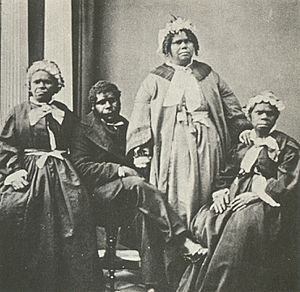Bruny Island Tasmanian language facts for kids
Quick facts for kids Bruny Island |
|
|---|---|
| Nuenonne | |
| Region | Bruny Island, Tasmania |
| Ethnicity | Bruny tribe of Tasmanians |
| Extinct | perhaps 8 May 1876, with the death of Truganini |
| Language family |
Eastern Tasmanian
|
| Dialects |
Milligan vocabulary
|
| AIATSIS | T5 (includes SE Tasmanian) |
Bruny Island Tasmanian, also called Nuenonne ("Nyunoni"), was an Aboriginal language spoken by the Bruny tribe on Bruny Island. This island is located off the southeastern coast of Tasmania. It is believed that the last speaker of this language was Truganini, who passed away in 1876.
We know about Bruny Island Tasmanian from several old word lists. Joseph Milligan collected a list of 986 words. George Augustus Robinson collected 515 words, Charles Sterling gathered 273 words, and R.A. Roberts recorded 111 words. These lists help us understand what the language was like.
Contents
Understanding the Bruny Island Language
The only known "running text" (like a full sentence or speech) ever recorded for any Tasmanian language comes from Bruny Island. This text is a sermon that George Augustus Robinson preached to the Aboriginal people on Bruny Island.
Robinson stayed on the island for eight weeks. He wrote down the sermon by replacing English words with Bruny Island words. However, he did not include the correct grammar of the Bruny Island language. This means the sermon does not show us how the language was truly spoken. It is more like a word-for-word translation from English.
History of the Bruny Island People
The story of the Bruny Island language is closely linked to the life of Truganini. She is widely known as the last full-blooded Tasmanian Aboriginal person. Truganini was the daughter of Mangana, who was a leader of the Bruny Island people. Her name came from a word her tribe used for a plant called the grey saltbush.
When she was young, Truganini took part in her people's traditional way of life. However, the arrival of Europeans greatly changed Aboriginal life in Tasmania.
European Arrival and Impact
In 1824, Lieutenant-Governor George Arthur arrived in Van Diemen's Land (which is now Tasmania). He introduced new rules to deal with the growing problems between European settlers and the Aboriginal people. One rule offered rewards for bringing in Aboriginal adults and children. Another rule tried to build friendly relationships with Aboriginal people to encourage them to live in special settlements. This effort began on Bruny Island, where there had been fewer conflicts than in other parts of Tasmania.
When Truganini met George Augustus Robinson in 1829, her family had already suffered greatly. Her mother had been killed, her uncle shot, her sister taken away, and her fiancé had died. Robinson was known as the "Protector of Aborigines."
In 1830, Robinson moved Truganini and another Aboriginal person named Woorrady to Flinders Island. They went with the last surviving Tasmanian Aboriginal people, about 100 in total. The goal was to keep them safe. However, many of the group became sick and died from diseases like influenza. Truganini also helped Robinson with a settlement for Aboriginal people from mainland Australia in 1838.
Later Life and Return to Tasmania
After living near Melbourne for about two years, Truganini joined a group of other Tasmanian Aboriginal people. They were involved in conflicts with settlers. They traveled to different areas, including Bass River and Cape Paterson. During this time, two whalers were killed. The group was captured and faced trial. Truganini had a head injury that was treated by a doctor. The two men in the group were found guilty and executed in 1842. Truganini and most of the other Tasmanian Aboriginal people were sent back to Flinders Island a few months later.
In 1856, the few remaining Tasmanian Aboriginal people on Flinders Island, including Truganini, were moved to a settlement at Oyster Cove. This place is south of Hobart.


